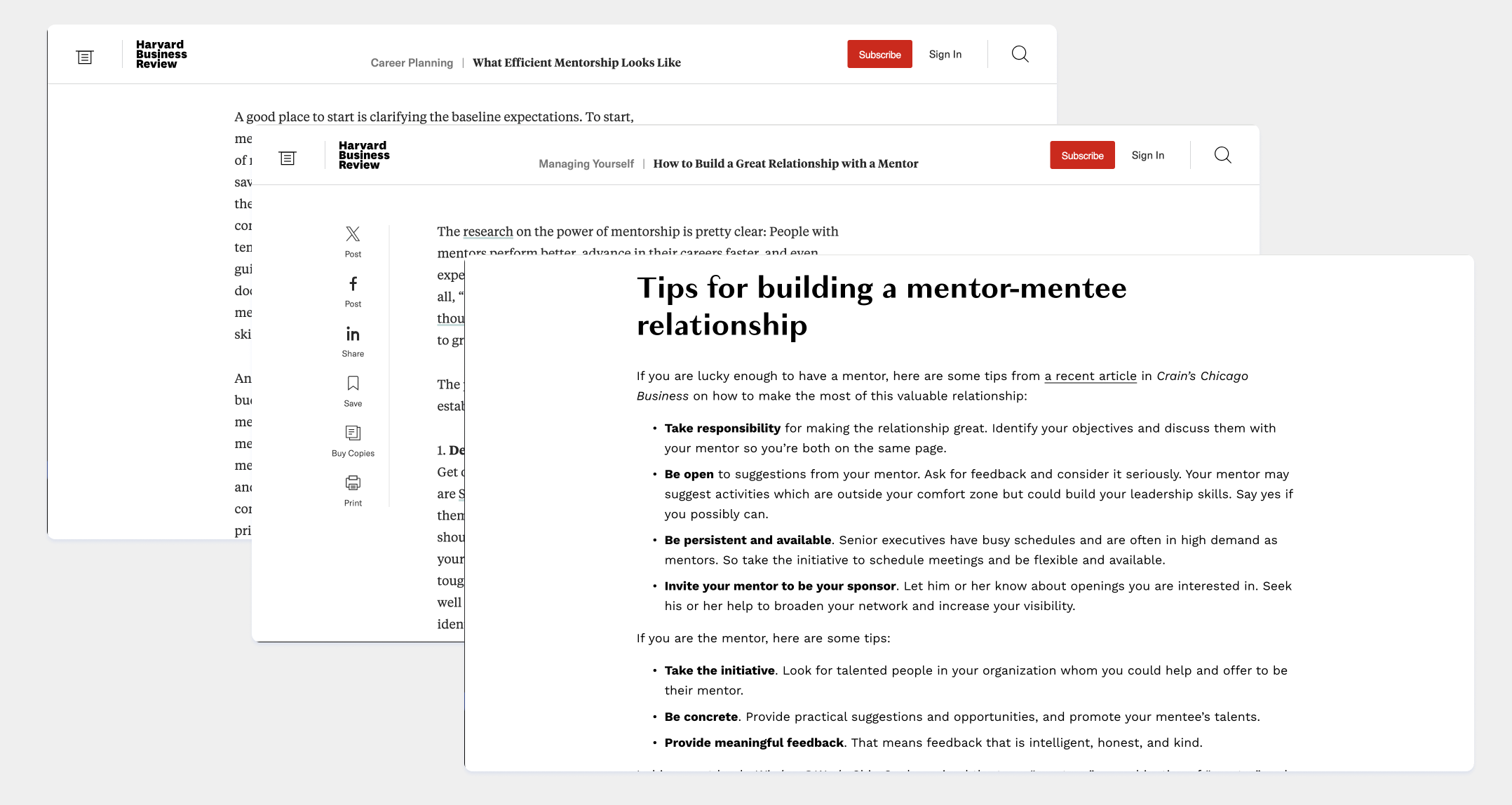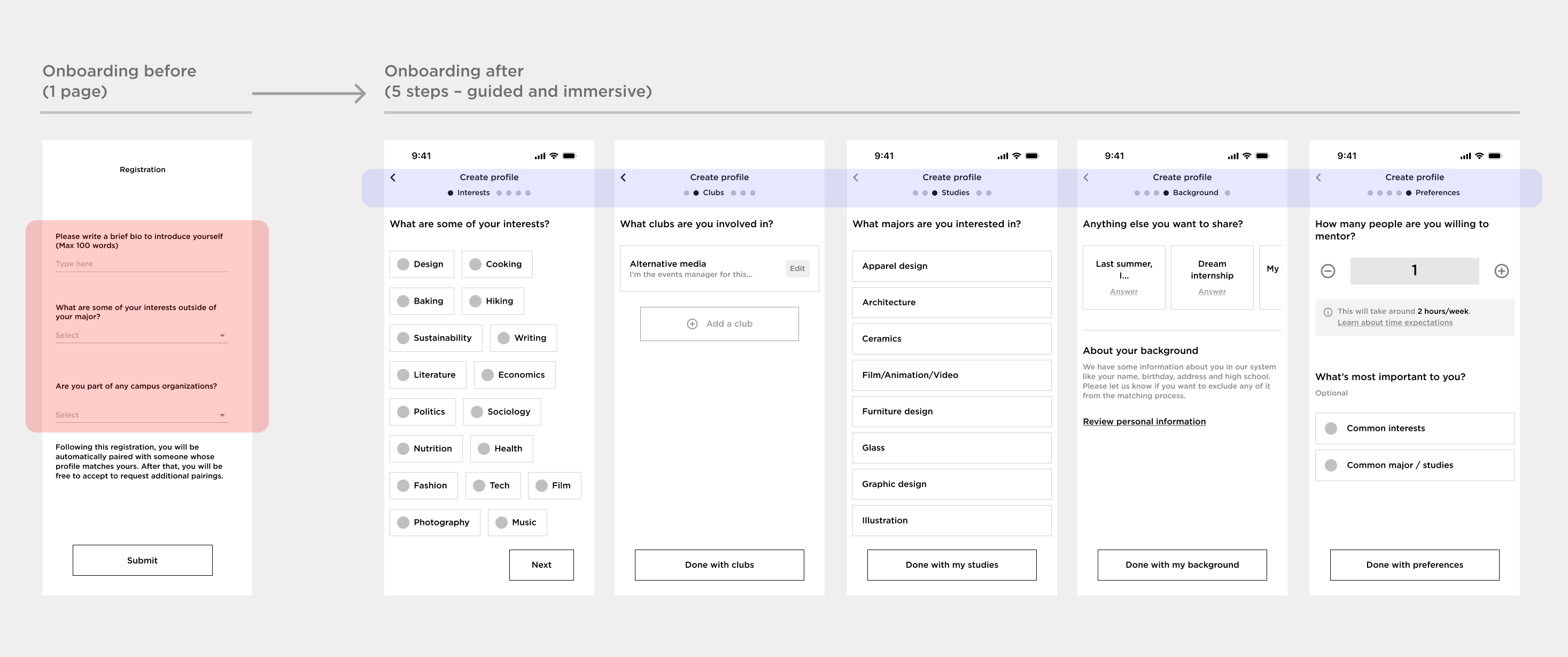A mentorship app for RISD students
Personal project · 2020

Overview
While mentorships offer a lot of advantages, they often disintegrate. How might we design for students to form stronger, lasting mentorships?
Background
This was a class project where I was the sole designer, though I had help from classmates and friends for research, testing and feedback.
Timeframe
The original timeframe was 2 weeks, but I later spent more time testing and refining flows
Table of contents
01. Research
Gathering user data
Questionnaire · 45 RISD students
To better understand my users and their mentorship needs, I devised a brief questionnaire that I sent to 45 people about their experience as mentors and/or mentees.
I kept the form short to avoid overwhelming respondents, but the questions are open-ended so that they can elaborate on their answers.

Highlights from user responses
Chemistry is important
75% think chemistry is a key aspect of a mentorship
Uncertainty predominates
90% feel uncertain about next steps after being paired
Expectations are fuzzy
75% don't know the specifics of what's expected from mentorships
Reading up on the topic
User research is useful, but I also wanted to take advantage of online resources to understand more about the topic of mentorships. The articles I read included:

Article highlights
Mentorships require work
Mentorships often fail because people can't find the time and don't feel accountable to do so.
Goals should be specific
Concrete goals and expectations help to measure benefits and keep both people engaged.
Transparency is key
Encouraging honest, constructive communication helps to get value out of a mentorship.
02. Analysis: User personas + journeys
Drawing from my research, I created two user personas (mentor and mentee) that matched common situations I found in my research. I then mapped their journeys to identify pain points and opportunities.

Katie · Mentor · Senior in FAV
Katie is sociable and empathetic. She keeps herself busy and as a result, she sometimes forgets about some of her commitments.

Pain points
Uncertainty about how to be a good mentor
She hasn't discussed expectations with her mentee
Busy calendar means she might abandon the project
Opportunities
Tips on responding to situations
Guidance on how to get value from the mentorship
Suggested steps and alerts to stay on top of commitments

Paul · Mentee · Freshman
Paul wants to take advantage of school resources, and feels a mentor would be helpful. However, he has social anxiety and worries about meeting new people.

Pain points
Anxiety about not getting along with a future mentor
Unsure about what’s expected of the mentorship and how it will work
Opportunities
Offer guidance about what’s expected of a mentorship and encourage discussing it early on.
Have the option to get a second mentor if the first doesn’t work out.
03. Goals
For someone entering into a mentorship, the process is vague and there is little guidance on how to handle different circumstances. What would a successful product need to accomplish to enable mentors and mentees?
Support friendships
Foster personal relationships while protecting people from bias and rejection
Give advice
Teach users how to manage and take advantage of their mentorship
Define expectations
Make it easy to set and follow an appropriate plan after being matched
04. Ideation
I started my ideation by thinking about design choices that would best meet the users' goals. What features would nurture relationships, create structure, and help educate users?
Onboarding questions
Questions are important to get to know people better, which helps during the matching process
Multiple pairings
Mentees can request an additional mentor after some time, if their original pairing isn't working out.
Suggestions
Offer suggestions on what to do next so users have a goal in mind
Tips
Offer guidance and advice to educate users on making the most of their mentorship
Inform ahead of time
Weave in information that lets users know what's expected
Plans
Offering a set of recommended steps provides structure and specificity
Sketching + IA
After thinking about the problem and drawing up some sketches, I came up with a broad structure for the app, with 4 main areas: a home with tracking and reminders, an inbox, an area to browse mentor profiles, and a place for additional content.
I also outlined flows for important tasks, like getting started and scheduling the first meeting.

05. Wireframing + User Testing
Once I had an idea of the features I wanted to add and the overall structure, I created a first prototype to test. It had a side menu to get to secondary pages, a homepage for reminders and tracking progress, and a section to find new mentors.

Testing + results
For my tests, I asked 2 people to sign up as a mentor, and 2 to do so as a mentee and request a new mentor. Everyone was asked questions about what they saw and felt at each step.
What worked
Having a plan: People liked tracking next steps and getting reminders.
Tips: Participants felt supported when seeing tips and thought they were useful.
Looking for a mentor: The experience of browsing for new mentors worked well.
What could be better
Signing up: The flow was too quick and people felt the format and word limit was restricting.
Meetings vs. goals: Testers wondered why meetings and goals were separate. It wasn't clear how to customize the initial plan.
The side menu: It went largely unnoticed by some participants.
Responding to feedback
To address some of the items that came up during testing, I expanded the onboarding flow, making it more immersive and providing more opportunities for users to expand on their interest and background.

I also changed around the navigation by adding a tracking area and a profile more directly accessible from home, and eliminated the hamburger menu. When it came to progress, meetings and goals were consolidated into tasks, which simplified the process and made it clearer.

06. Design
The visual style follows the RISD brand, and feels put together (as an official school app) but also youthful, with fun pops of color. I put together prototypes for the onboarding flow, getting started, and requesting a mentor.

How do users sign up and create a profile?
01. Signing up
A warm welcome
Once the user logs in, they get a welcome screen before selecting their role.
A transition into profile questions
After selecting their role, a screen asks users to fill out their profile and explains the value of the onboarding questions.
02. Creating a profile
An immersive flow
The onboarding flow takes users through a series of guided question—interests, clubs, studies.
An opportunity to share more
Students can add a note about their interests or club involvements. In the background section, optional prompts like 'Dream internship' encourage users to share more about themselves.
How do users get started with a mentorship?
Suggestions for next steps
The app makes it easy to get started with a mentee by elevating an empty state of the intro meeting, with a CTA to schedule it.
An overview of what's coming
Users can easily see their progress with a progress tracker and "next up" steps, drawn from a basic mentorship plan that's automatically assigned to users (found under "track").
Contextual education
Contextual tips and timely resources help to educate users about upcoming tasks and set them up for success.
How do mentees request an extra mentor?
Filter and view profiles
Mentees can browse mentors' profiles using different filters. There are no pictures to prevent bias.
Understanding the expectations
When mentees write a request to a mentor, a tip reminds them how much time a new mentor will add to their week, to keep them from overcommitting
Takeaways
It's easy to abandon mentorships, particularly in a student setting, and getting people to share details about themselves and feel accountable for continuing it is challenging.
Throughout this project, I went through different iterations of trying to find a balance between asking for information and suggesting next steps, and not overwhelming the user with things to do.
Overall, this was a great project to familiarize myself with patterns like onboarding, progress tracking and contextual education.